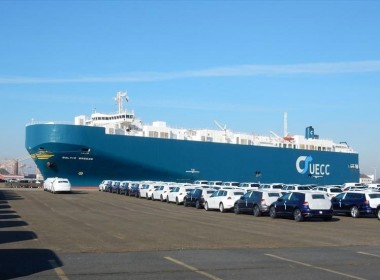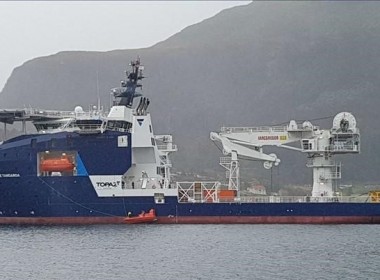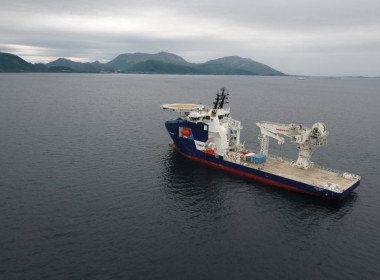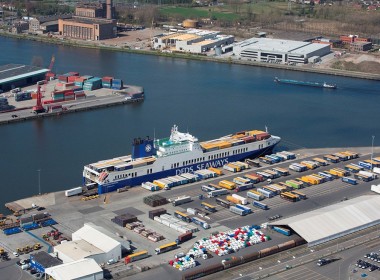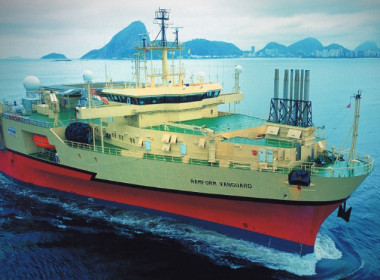REMINISCENCES | On the wheat run with self-discharging bulk carrier North Esk

In 1976 I was invited to join the North Esk in Newcastle. The local office instructed me to go down to the Western basin wheat berth to sign on. But when I arrived, there was no sign of a ship.
I rang the office from a public phone on the wharf and said their intel was all wrong. “There’s no ship here,” I said. The manager told me to go to the edge of the wharf and look down. Sure enough, I was looking down into the funnel of the North Esk.
Admittedly it was low tide but to say that the North Esk was a tiny ship was no exaggeration. At just on 80 metres long she would fit comfortably on the foredeck of any other ship in the ANL fleet. She was a ship ideally suited to inter-island trading or short coastal runs around northern Australia. But alas, the North Esk’s lot in life was to ply the wild waters of Bass Strait with a regular supply of wheat to Tasmania.
Dripping with 650 horsepower, the non-turbocharged British Polar engine pushed her along at a brisk eight knots on a good day (and a favourable wind). On a bad day (which were most days in Bass Strait) she could only manage about four knots. One memorable day off Cape Nelson lighthouse in Victoria we averaged zero knots in 24 hours. The same light flashing on and off to our port side on both my morning and evening watch.
“Trying to recover the contents of his suitcases which had burst open on impact”
In spite of all these things I grew quite attached to the old North Esk and fondly remember all the good times which were few and the harrowing times (which were many).
The Chief Steward was an aboriginal guy called Jack Hedley. Probably the only indigenous person in the whole fleet. A kind and generous guy, he would often supplement our bill of fare with fresh fish he horse-traded with wharf fishermen at the many obscure mainland ports we frequented.
Probably the most memorable of these ports was Ardrossan in South Australia. It had an incredibly long T jetty with a conveyor running down its full length. Now, for whatever the reason, ANL had to change out a crewmember and the only way to get him to Ardrossan was to send him by taxi from Adelaide, a journey of some 150 kilometres.
To break up the monotony of the trip this gentleman chose to be accompanied by a carton of beer. By the time he arrived at Ardrossan he was feeling at peace with the world but very tired. The daunting spectacle of the long walk along the jetty to the ship with his suitcases awakened something in his dulled thoughts.
“Surely I can put my cases on the conveyor belt and just walk beside them” he thought. Unfortunately, the belt was a lot faster than he was and his suitcases started to get away from him. He was last seen crawling around on hands and knees on the rat screens over the cargo hold being showered in wheat and trying to recover the contents of his suitcases which had burst open on impact. A sobering exercise if ever there was one. Just one of the vivid memories of my time on the North Esk.
The ship’s main trade was to supply Tasmania with just enough wheat for their needs. Every so often we’d turn up with about 2,000 tonnes of wheat which was just enough for the bread makers of Tassie.
“But woe-betide anyone trying to run anything else while the auger was working”
To the best of my knowledge, the North Esk was the last trading ship to run down the Tamar River to Launceston, a beautiful but bumpy trip when the ship was fully laden. At Launceston the Tamar branched off into the North Esk and South Esk Rivers, hence the name. The return trip in ballast was far less bumpy but venturing out into the turbulent waters of Bass Strait was something of a lottery depending on the weather.
Not for the first time, were we swept back into Bell Bay to wait until the seas subsided. Or we could go to periscope depth and hope for the best. One heart stopping afternoon I experienced what it was like to broach down the face of a large following wave. It was a sickening feeling as the skipper slowly and ever so painstakingly turned the ship back into the weather.
With so many variables at play it was impossible to meet any sort of schedule. One trip from Portland in Victoria to Hobart (down the west coast) took us eleven days. The Brisbane Trader passed us four times during this trip. Twice northbound and twice southbound heading for Devonport.
Although the smallest ship in the fleet, it’s hard to believe that at one time, tonne for deadweight tonne, it was the most profitable ship in ANL. This was due to the ingenious screw and auger conveyor system for discharging wheat. At the time it was the only self-discharging bulk carrier in the world.
But woe-betide anyone trying to run anything else while the auger was working. The North Esk was a DC ship so any increase in electrical load immediately reduced the picture on the TV set to the size of a postage stamp. The alert duty engineer would see this happen and immediately bolt for the bridge to catch the gyrocompass before it toppled over. It was easy to restart the auger but it took hours to run the gyro up to speed if it fell over.
The skill-set I developed on the North Esk prepared me for many things later in life. These were to expect the unexpected and whatever doesn’t kill you…well, good to have survived.
Submissions wanted! Do you have an exciting, amusing or downright dangerous anecdote from your time in the maritime world? Each week, we will feature new personal experiences from across the globe. Submissions to: [email protected].


